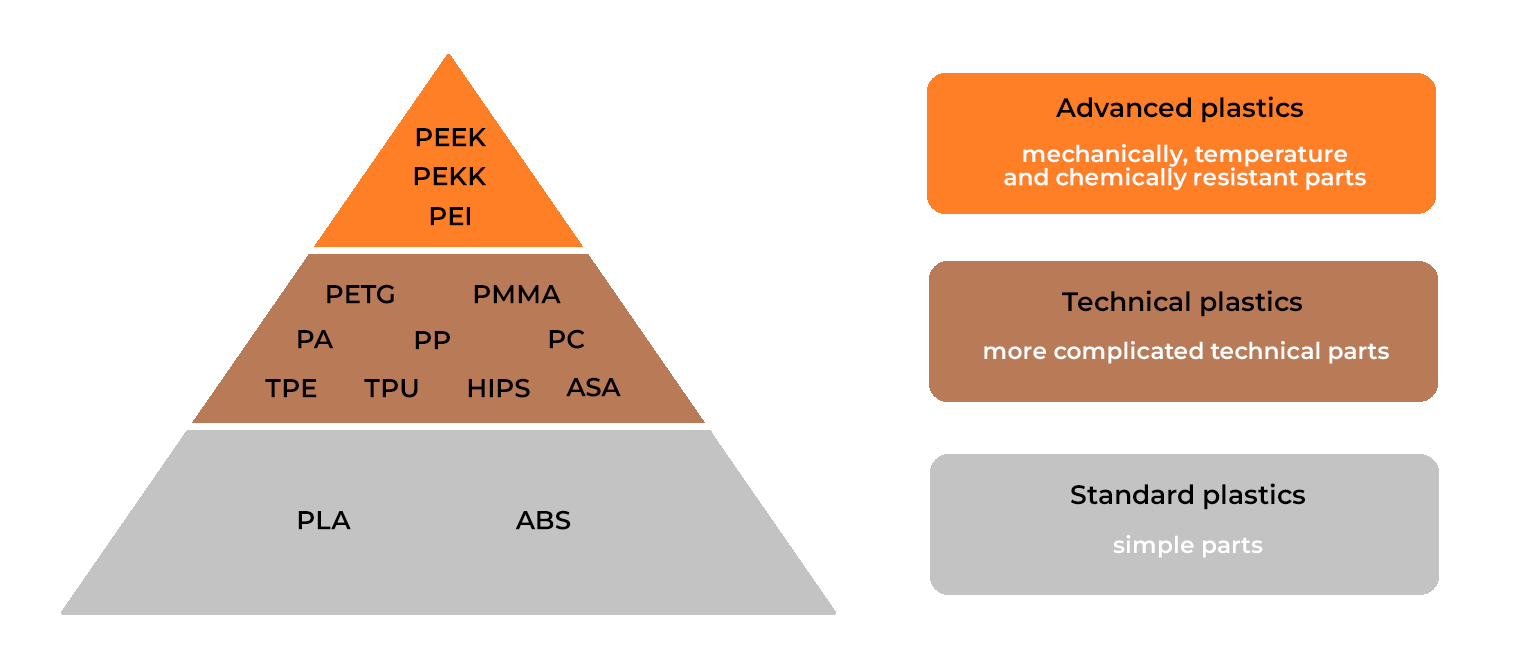
Regularly updated list of 3D materials
Choose from a wide range of materials based on your requirements and printing technology. Below you will find the description, specifications and technical parameters for all the production materials we offer.
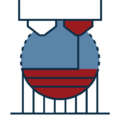
FDM printing technology
``Fused Deposition Modeling``
it prints using a cord made of solid thermoplastic (filament), pushing it through a heated nozzle. The printer layers the material onto a build platform in a predetermined path, where the filament cools and solidifies to form a solid part.
PLA
Polyactide fibers of lactic acid /PLA/ is a biodegradable material. Suitable for prototypes in various industries. Ideal for sample prototypes used in interiors. The material is not suitable for outdoor use due to its low temperature resistance.
• relatively rigid and solid material
• low chemical resistance
• poor temperature resistance
• it is possible to create connected or chained parts
• tolerance from ±0.50 mm
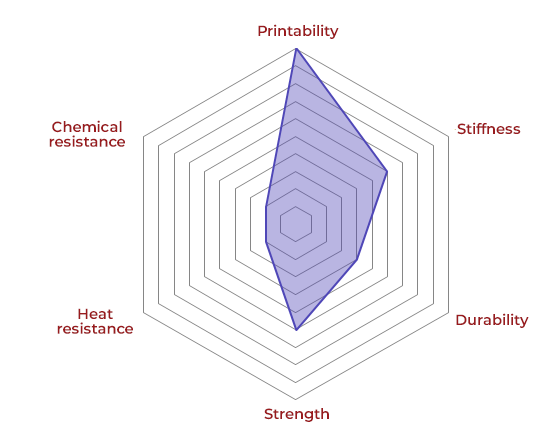
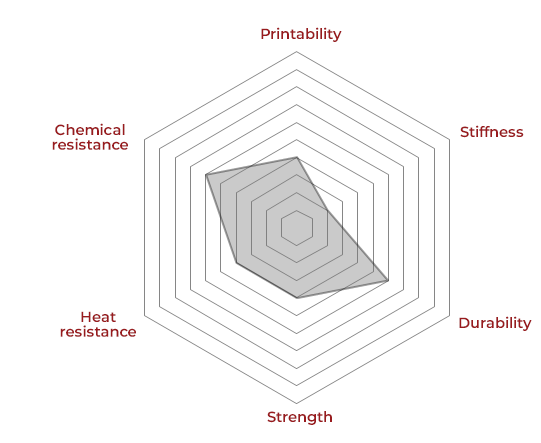
ABS
Acrylonitrile butadiene styrene /ABS/ is an amorphous thermoplastic copolymer. The copolymer is resistant to mechanical damage, easy to shape and resistant to aggressive chemical compounds. Suitable for prototypes in various industries.
• relatively solid material
• good chemical resistance
• good temperature resistance
• it is possible to create connected or chained parts
• tolerance from ±0.50 mm
PETG
Polyethylene terephthalate – glycol /PET-G/ is a popular material combining the best properties of ABS and PLA. It has higher temperature resistance than PLA, is more flexible and durable. Suitable for prototypes and functional parts in various industries.
• relatively stiff, strong and flexible material
• good chemical resistance/span>
• good temperature resistance
• it is possible to create connected or chained parts
• tolerance from ±0.50 mm
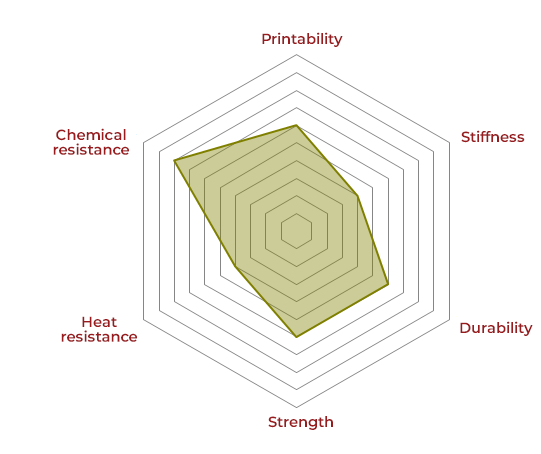
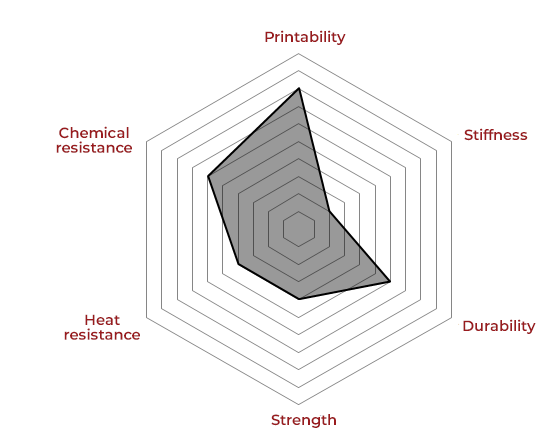
ASA
Acrylonitrile-styrene-acrylate /ASA/ is an alternative to ABS and has been specially developed to withstand the vagaries of the weather. It is therefore suitable for outdoor use. It is strong, stiff and relatively easy to print. The material is also extremely resistant to chemical influences and heat.
• relatively rigid and solid material
• good chemical resistance
• good temperature resistance
• it is possible to create connected or chained parts
• tolerance from ±0.50 mm
TPU
Thermoplastic polyurethane /TPU/ is a flexible material resistant to chemical substances. Its other advantage is lower shrinkage and better retention of elastic properties at lower temperatures.
• flexible material
• good chemical resistance
• low temperature resistance
• it is not possible to create connected or chained parts
• tolerance from ±0.50 mm
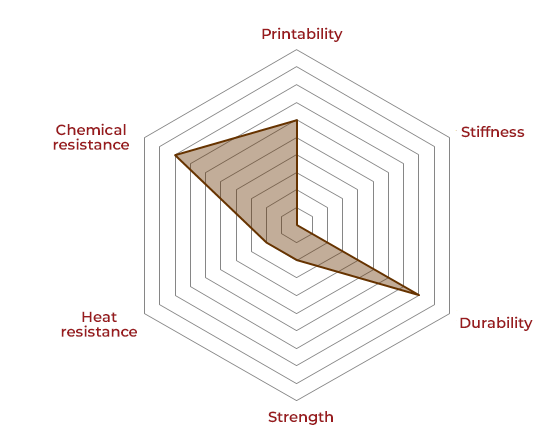

Nylon
Nylon – polyamide /PA/ is an extremely strong, durable and versatile material, specifically a synthetic polymer. It is strong, flexible in thin layers, but with very high adhesion between layers. It has a high melting point, but it is very hydroscopic /binds water/.
• rigid and solid material
• high moisture absortion
• high chemical resistance
• high temperature resistance
• it is possible to create connected or chained parts
• tolerance from ±0.50 mm
PC
PC /polycarbonate/ is a strong and heat-resistant material. Due to its impact resistance, it is suitable for stressed parts.
• rigid and solid material
• high chemical resistance
• good temperature resistance
• it is possible to create connected or chained parts
• tolerance from ±0.50 mm

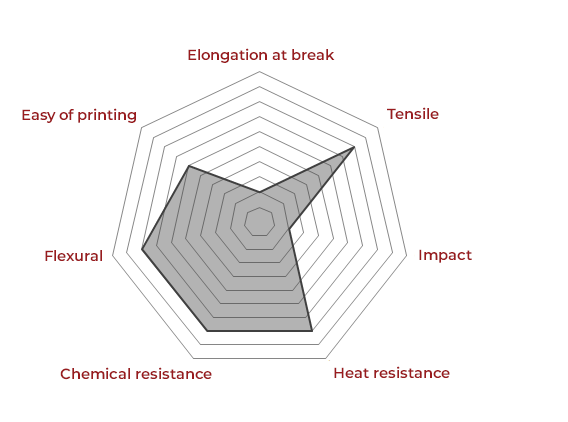
PA CF
Nylon – polyamide with carbon admixture /PA + Carbon Fiber/ offers advanced mechanical properties, dimensional stability and chemical resistance. Indispensable in applications where extreme lightness and rigidity are required.
• very rigid and strong material
• high chemical resistance
• high temperature resistance
• tolerance from ±0.50 mm
PEEK
Polyether ether ketone /PEEK/ has exceptional mechanical properties and can achieve a tensile strength of up to 89 MPa. In addition, it can be used in continuous operation up to 145 ° C and in shock temperature up to 250 ° C. Due to its extraordinary performance combined with lightness, it is widely used as a metal substitute in the aerospace and military industries.
• very rigid and strong material
• very high chemical resistance
• very high temperature resistance
• it is not possible to create connected or chained parts
• tolerance from ±0.50 mm
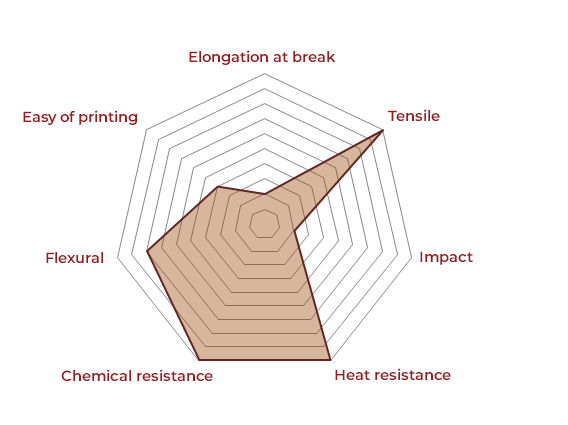

PEEK CF
Polyether ether ketone with carbon admixture /PEEK + Carbon Fiber/ has exceptional mechanical properties and the addition of carbon fiber improves its performance, making it one of the most powerful polymers available. Heat resistance has been significantly improved by reaching a temperature of up to 315 °C before deformation (HDT 0.8 MPa). Due to its extraordinary performance combined with lightness, it is widely used as a metal substitute in the aerospace and military industries.
• very rigid and strong material
• very high chemical resistance
• very high temperature resistance
• it is not possible to create connected or chained parts
• tolerance from ±0.50 mm
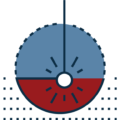
SLS printing technology
``Selective Laser Sintering``
it starts with a reservoir of polymer powder heated to a temperature just below the melting point of the polymer. And the application blade applies a very thin layer of powder material (typically 0.1 mm) to the mounting platform. A CO2 laser beam is then fired to scan the surface. The laser selectively sinters the powder and hardens the cross-section of the part.
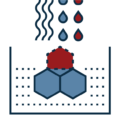
MJF printing technology
``Multi Jet Fusion``
uses fine-grained materials that enable ultra-thin layers with a thickness of 80 microns. This results in parts with high density and low porosity compared to parts made by laser sintering. This also results in an exceptionally smooth surface straight from the printer, and functional parts require minimal post-production treatment. Ideal for functional prototypes and small series of end parts.
PA12
Strong thermoplastic for functional prototyping and final parts. Excellent chemical resistance to oils, fats and hydrocarbons. Optimal for additional surface treatment /post-processing/.
• rigid and durable material
• excellent chemical resistance to oils, fats, aliphatic and alkaline hydrocarbons
• good temperature resistance
• excellent base for subsequent surface treatments
• it is possible to create connected or chained parts
• tolerance from ±0.30 mm
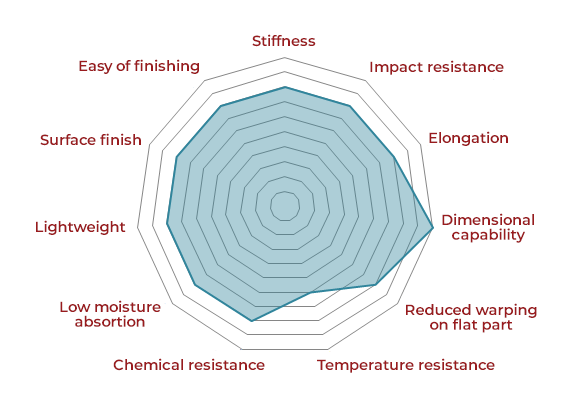
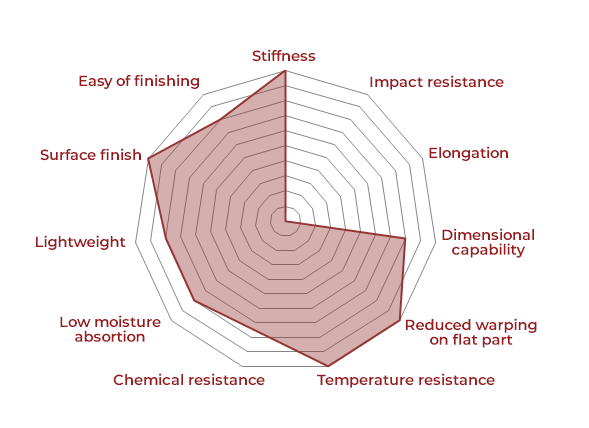
PA12 + GB
PA12 Glass Beads is a nylon plastic filled with glass beads that improve product stiffness and structural integrity. This material is great for flat and large parts that are prone to distortion and for functional parts that require high strength and dimensional accuracy.
• rigid and durable material
• good chemical resistance to oils, fats, aliphatic and alkaline hydrocarbons
• excellent temperature resistance
• excellent base for subsequent surface treatments
• it is possible to create connected or chained parts
• more brittle than PA12
• unsuitable for thin walls and small details
• tolerance from ±0.30 mm
PA11
Nylon PA11 is ideal for mechanically loaded functional parts in a series with long-term moving elements such as hinges or parts intended for shock absorption.
• rigid and durable material
• good chemical resistance
• good temperature resistance
• excellent base for subsequent surface treatments
• it is possible to create connected or chained parts
• excellent resistance to impact and wear
• tolerance from ±0.30 mm

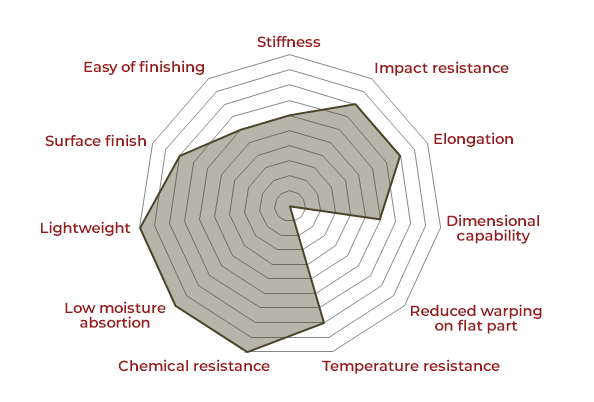
PP
Polypropylene /PP/ is a very light material. Ideal for prototypes, automotive interiors, pipes and fluid tanks, machine parts, medical equipment and cosmetics.
• light material 0.89 g / cm³
• very good chemical resistance
• good temperature resistance
• tolerance from ±0.60 mm
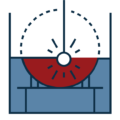
SLA printing technology
``Stereolithography``
the process uses mirrors, known as galvanometers or galvos (one on the x-axis and one on the y-axis) to rapidly direct a laser beam through a vat of material, causing the resin to harden and solidify. This process breaks down the design layer by layer into a series of points and lines that are given to the galv as a set of coordinates. Most SLA printers use a semiconductor laser to harden the parts.

DLP printing technology
``Direct Light Processing``
follows an almost identical way of producing parts as SLA. The main difference is that DLP uses the projector's digital light to flash one image of each layer at a time (or multiple flashes for larger sections). Because the projector is digital on the screen, the image of each layer is made up of square pixels, resulting in a layer made up of small rectangular bricks called voxels.
ABS like resin
It will cover the needs of users looking for extremely smooth surfaces and a high level of detail. Use especially for aesthetic parts /not recommended for functional or mechanical parts/.
• suitable for aesthetic parts and prototypes
• very smooth surface with a very high level of detail
• this material is not suitable for functional or mechanical parts
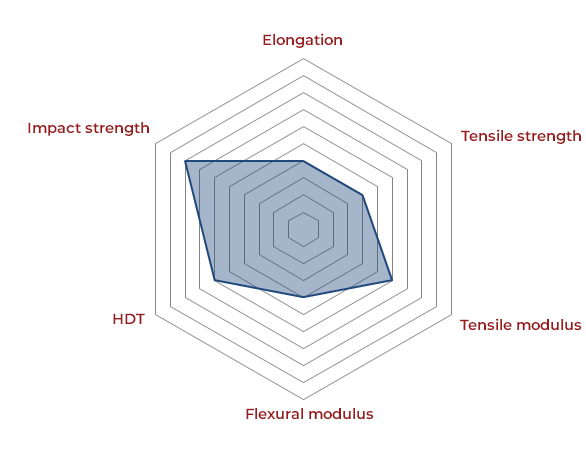
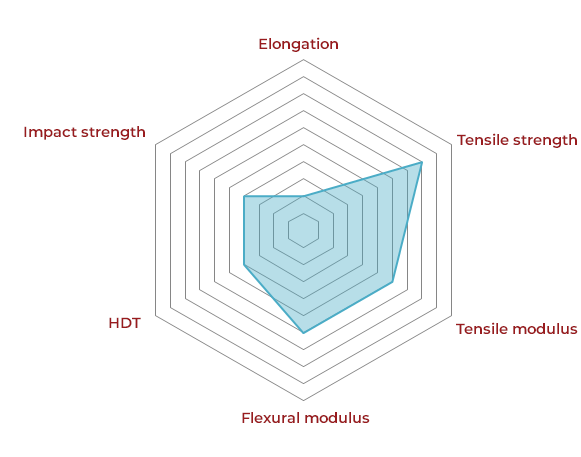
Clear resin
The transparent resin with a translucent surface /or frost effect/ provides an aesthetically pleasing and homogeneous appearance and at the same time enables a high level of detail /50 µm/. It will cover the needs of users looking for extremely smooth surfaces and a high level of detail. Use especially for aesthetic parts /not recommended for functional or mechanical parts/.
• suitable for aesthetic parts and prototypes
• very smooth surface with a very high level of detail
• this material is not suitable for functional or mechanical parts
• semi-transparent material
• yellowing and degradation over time
Tough resin
Tough resin is ideal for all industrial mechanical applications: it is an extremely malleable, flexible and elastic material with an excellent level of detail. It is used in industry for the production of final parts exposed to shock and impact and for functional prototypes.
• malleable, flexible and elastic
• very smooth surface with a very high level of detail
• the perfect combination of mechanical properties to produce functional components
• limited chemical resistance
• limited stability over time

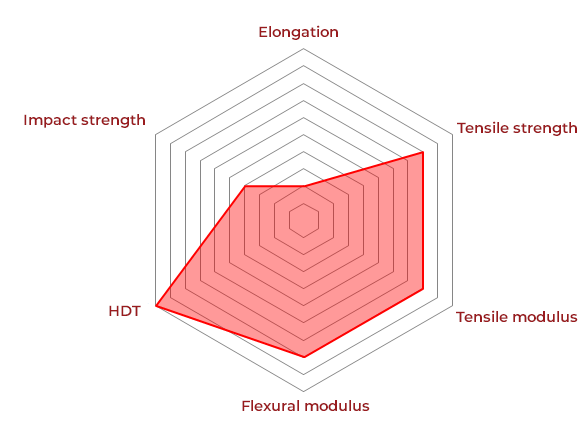
High temp resin
For parts that require a fine resin finish and must be used in contact with hot liquids up to 190°C or in a high temperature working environment.
• excellent for functional and demonstration prototypes of heat-stressed objects
• very smooth surface with a very high level of detail
• very good temperature resistance
• limited stability over time
Classification of plastics
Division of plastics according to type of purpose and use.
